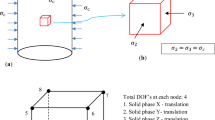Abstract
The seismic hazard is relatively higher in Northern India due to the presence of the Himalayas encompassing many regional features like Main Boundary Thrust (MBT), Main Central Thrust (MCT) and Himalayan Frontal Thrust (HFT). Implicitly, estimation of liquefaction potential becomes of paramount interest due to the presence of deep soils in this region. Indo-Gangetic basin is composed of thick alluvium deposits where thickness of sand layer may extend up to 30 to 40 m. In the present study, a fully coupled finite element analysis is incorporated for modeling liquefaction phenomena for soil domain up to 30 m depth subjected to cyclic ground excitation of 0.2 g ground acceleration. Moreover, a parametric study is carried out to explore the liquefaction behavior on saturated sand layer of variable thickness. The ratio (Hliq/Hsand) is increasing with depth (0.5, 0.8, 0.833) highlighting the effect of drainage path.











Similar content being viewed by others

References
Biot MA (1941) General theory of three-dimensional consolidation. J Appl Phys 12(2):155–164
Biot MA (1956) Theory of propagation of elastic waves in a fluid-saturated porous solid. II. Higher frequency range. J Acoust Soc Am 28(2):179–191
Byrne PM, Park SS, Beaty M, Sharp M, Gonzalez L, Abdoun T (2004) Numerical modeling of liquefaction and comparison with centrifuge tests. Can Geotech J 41(2):193–211
Castro G (1975) Liquefaction and cyclic mobility of saturated sands. J Geotech Engg ASCE 101(GT6):551–569
Deresiewicz H (1960) The effect of boundaries on wave propagation in a liquid-filled porous solid: I. Reflection of plane waves at a free plane boundary (non-dissipative case). Bull Seismol Soc Am 50(4):599–607
Deresiewicz H, Rice JT (1962) The effect of boundaries on wave propagation in a liquid-filled porous solid: III. Reflection of plane waves at a free plane boundary (general case). Bull Seismol Soc Am 52(3):595–625
Derski W (1978) Equations of motion for a fluid-saturated porous solid. Bull Acad Pol Sci Ser Technol 26(1):11–16
Dewoolkar MM, Chan AH, Ko HY, Pak RY (2009) Finite element simulations of seismic effects on retaining walls with liquefiable backfills. Int J Numer Anal Methods Geomech 33(6):791–816
Halpern MR, Christiano P (1986) Steady-state harmonic response of a rigid plate bearing on a liquid-saturated poroelastic halfspace. Earthq Eng Struct Dyn 14(3):439–454
Katona MC, Zienkiewicz OC (1985) A unified set of single step algorithms part 3: the beta-m method, a generalization of the Newmark scheme. Int J Numer Methods Eng 21(7):1345–1359
Kramer SL (1996) Geotechnical earthquake engineering. Pearson Education, New Delhi
Kumar A, Kumari S (2019) Numerical modeling of shallow foundation on liquefiable soil under sinusoidal loading. Geotech Geol Eng 37:517–532
Kumar SS, Dey A, Krishna AM (2018) Response of saturated cohesionless soil subjected to irregular seismic excitations. Nat Hazards 93(1):509–529
Kumar SS, Krishna AM, Dey A (2017) Evaluation of dynamic properties of sandy soil at high cyclic strains. Soil Dyn Earthq Eng 99:157–167
Madabhushi SP, Zeng X (1998) Seismic response of gravity quay walls. II: numerical modeling. J Geotech Geoenviron Eng 124(5):418–427
Nova R, Wood DM (1982) A constitutive model for soil under monotonic and cyclic loading. In: Pande GN, Ziekiewicz OC (eds) Soil mechanics-transient and cyclic loading. Wiley, Chichester, pp 343–373
Oka F, Yashima A, Shibata T, Kato M, Uzuoka R (1994) FEM-FDM coupled liquefaction analysis of a porous soil using an elasto-plastic model. Appl Sci Res 52(3):209–245
Pastor M, Zienkiewicz OC (1986) A generalized plasticity, hierarchical model for sand under monotonic and cyclic loading. Int Symp Numer Models Geomech 2:131–150
Pastor M, Zienkiewicz OC, Leung KH (1985) Simple model for transient soil loading in earthquake analysis. II. Non-associative models for sands. Int J Number Anal Methods Geomech 9(5):477–498
Popescu R, Prevost JH (1993) Centrifuge validation of a numerical model for dynamic soil liquefaction. Soil Dyn Earthq Eng 12(2):73–90
Sadeghian S, Manouchehr LN (2012) Using state parameter to improve numerical prediction of a generalised plasticity constitutive model. J Comput Geosci 51:255–268
Seed B (1979) Soil liquefaction and cyclic mobility evaluation for level ground during earthquakes. J Geotech Geoenviron Eng 105:201–255
Seed B, Lee KL (1966) Liquefaction of saturated sands during cyclic loading. J Soil Mech Found 92:105–134
Taiebat M, Dafalias YF, Peek R (2010) A destructuration theory and its application to SANICLAY model. Int J Numer Anal Methods Geomech 34(10):1009–1040
Zienkiewicz OC, Mroz Z (1984) Generalized plasticity formulation and applications to geomechanics. Mech Eng Mater 44(3):655–680
Zienkiewicz OC, Paul DK, Chan AH (1988) Unconditionally stable staggered solution procedure for soil-pore fluid interaction problems. Int J Numer Methods Eng 26(5):1039–1055
Author information
Authors and Affiliations
Corresponding author
Ethics declarations
Conflict of interest
On behalf of all authors, the corresponding author states that there is no conflict of interest.
Rights and permissions
About this article
Cite this article
Sharma, P., Sawant, V.A. & Sharma, M.L. Numerical modeling of liquefaction in deep saturated sands. Innov. Infrastruct. Solut. 6, 86 (2021). https://doi.org/10.1007/s41062-020-00429-1
Received:
Accepted:
Published:
DOI: https://doi.org/10.1007/s41062-020-00429-1



